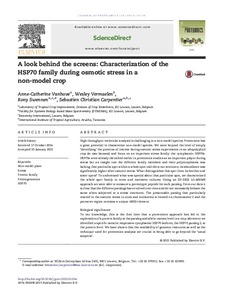| dc.contributor.author | Vanhove, A.C. |
| dc.contributor.author | Vermaelen, W. |
| dc.contributor.author | Swennen, R.L. |
| dc.contributor.author | Carpentier, S. |
| dc.date.accessioned | 2019-12-04T10:57:21Z |
| dc.date.available | 2019-12-04T10:57:21Z |
| dc.date.issued | 2015-04-24 |
| dc.identifier.citation | Vanhove, A. C., Vermaelen, W., Swennen, R., and Carpentier, S.C. (2015). A look behind the screens: Characterization of the HSP70 family during osmotic stress in a non-model crop. Journal of proteomics, 119, 10-20. |
| dc.identifier.issn | 1874-3919 |
| dc.identifier.uri | https://hdl.handle.net/20.500.12478/710 |
| dc.description.abstract | High-throughput molecular analysis is challenging in a non-model species. Proteomics has a great potential to characterize non-model species. We went beyond the level of simply ‘identifying’ the proteins of interest during osmotic stress experiments in an allopolyploid crop (in casu banana) and focus on an important stress family: the cytoplasmic HSP70s. HSP70s were already identified earlier in proteomics studies as an important player during stress but an insight into the different family members and their polymorphisms was lacking. One particular spot within a whole spot trail drew our attention: its abundance was significantly higher after osmotic stress. What distinguishes this spot from its brother and sister spots? To understand what was special about that particular spot, we characterized the whole spot family in roots and meristem cultures. Using an 2D-DIGE LC–MS/MS approach we were able to measure a proteotypic peptide for each paralog. From our data it is clear that the different paralogs have evolved over time and do not necessarily behave the same when subjected to a stress treatment. The presumable paralog that particularly reacted to the osmotic stress in roots and meristems is located on chromosome 2 and the promoter region contains a unique ABRE element.
Biological significance
To our knowledge, this is the first time that a proteomics approach has led to the exploration of a protein family at the paralog and allelic variant level in a crop. Moreover we identified a specific osmotic responsive cytoplasmic HSP70 isoform, the HSP70 paralog 2, at the protein level. We have shown that the availability of genomic resources as well as the technique used for proteomics analysis are crucial in being able to go beyond the ‘usual suspects’. |
| dc.format.extent | 10-20 |
| dc.language.iso | en |
| dc.subject | Hsp70 |
| dc.subject | Non-Model Plant |
| dc.subject | Stress |
| dc.subject | Protein Family |
| dc.subject | Proteogenomics |
| dc.title | A look behind the screens: Characterization of the HSP70 family during osmotic stress in a non-model crop |
| dc.type | Journal Article |
| dc.description.version | Peer Review |
| cg.contributor.crp | Agriculture for Nutrition and Health |
| cg.contributor.affiliation | Katholieke Universiteit Leuven |
| cg.contributor.affiliation | International Institute of Tropical Agriculture |
| cg.contributor.affiliation | Bioversity International |
| cg.isijournal | ISI Journal |
| cg.authorship.types | CGIAR and advanced research institute |
| cg.iitasubject | Crop Systems |
| cg.iitasubject | Food Systems |
| cg.journal | Journal of Proteomics |
| cg.howpublished | Formally Published |
| cg.accessibilitystatus | Limited Access |
| local.dspaceid | 70327 |
| cg.targetaudience | Scientists |
| cg.identifier.doi | https://dx.doi.org/10.1016/j.jprot.2015.01.014 |

